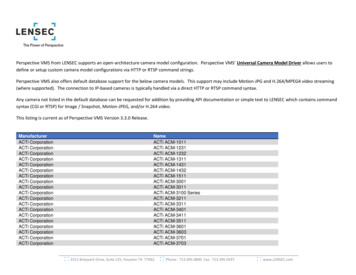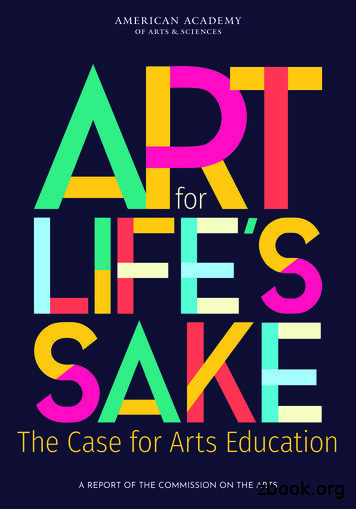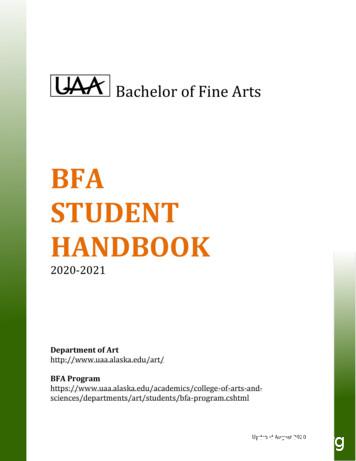Arts, AV Technology And Communications Career Cluster .
Georgia Department of EducationArts, AV Technology and Communications Career ClusterGraphic Design and ProductionCourse Number 48.56200Course Description:As the second course in the Graphics Communication and Graphics Design Pathways, thiscourse builds on knowledge and skills learned in the Introduction to Graphics and Designcourse and focuses on procedures commonly used in the graphic communication and designindustries. Students will gain more experience in creative problem solving and the practicalimplementation of those solutions across multiple areas of graphic design and graphiccommunications. The prerequisite for this course is Introduction to Graphics and Design.Course Standard 1AAVTC-GDP-1The following standard is included in all CTAE courses adopted for the Career Cluster/Pathways.Teachers should incorporate the elements of this standard into lesson plans during the course. Thetopics listed for each element of the standard may be addressed in differentiated instruction matchingthe content of each course. These elements may also be addressed with specific lessons from a varietyof resources. This content is not to be treated as a unit or separate body of knowledge but ratherintegrated into class activities as applications of the concept.Standard: Demonstrate employability skills required by business and industry.The following elements should be integrated throughout the content of this course.1.1Communicate effectively through writing, speaking, listening, reading, and interpersonal abilities.Person-to-PersonTelephone andCell Phone andCommunicating AtListeningEtiquetteEmail EtiquetteInternet EtiquetteWorkInteracting withTelephoneUsing BlogsImprovingReasons, Benefits,Your BossConversationsCommunication Skillsand BarriersInteracting withBarriers to PhoneUsing Social MediaEffective OralListening teracting withMaking andEffective WrittenWays We FilterCo-workersReturning CallsCommunicationWhat We HearInteracting withMaking Cold CallsEffective NonverbalDeveloping aSuppliersSkillsListening AttitudeHandling ConferenceEffective Word UseShow You AreCallsListeningHandling UnsolicitedGiving and ReceivingAsking QuestionsCallsFeedbackObtaining FeedbackGetting Others allyReading Body Languageand mixed MessagesMatching Verbal andNonverbal communicationImproving NonverbalIndicatorsWrittenCommunicationWriting DocumentsConstructiveCriticism in WritingSpeakingUsing LanguageCarefullyOne-on-OneConversationsSmall GroupCommunicationLarge GroupCommunicationGeorgia Department of EducationOctober 11, 2013 Page 1 of 7All Rights ReservedApplications and EffectiveRésumésCompleting a Job ApplicationWriting a Cover LetterThings to Include in a RésuméSelling Yourself in a Résumé
Georgia Department of EducationNonverbal FeedbackShowing ConfidenceNonverballyShowing Assertiveness1.2Making SpeechesInvolving theAudienceAnswering QuestionsVisual and Media AidsErrors in PresentationTerms to Use in a RésuméDescribing Your Job StrengthsOrganizing Your RésuméWriting an Electronic RésuméDressing Up Your RésuméDemonstrate creativity by asking challenging questions and applying innovative procedures andmethods.Teamwork and Problem SolvingMeeting EtiquetteThinking CreativelyPreparation and Participation in MeetingsTaking RisksConducting Two-Person or Large Group MeetingsBuilding Team CommunicationInviting and Introducing SpeakersFacilitating Discussions and ClosingPreparing Visual AidsVirtual Meetings1.3Exhibit critical thinking and problem solving skills to locate, analyze and apply information in careerplanning and employment situations.ProblemCustomer ServiceThe Application ProcessInterviewing SkillsFinding theSolvingRight JobTransferableGaining Trust andProviding Information,Preparing for anLocating Jobs andJob SkillsInteracting withAccuracy and DoubleInterviewNetworkingCustomersCheckingBecoming aLearning and GivingOnline ApplicationQuestions to Ask inJob ShoppingProblem SolverCustomers WhatProcessan InterviewOnlineThey WantIdentifying aKeeping CustomersFollowing Up AfterThings to Include in aJob SearchProblemComing BackSubmitting an ApplicationCareer PortfolioWebsitesBecoming aSeeing theEffective Résumés:Traits Employers areParticipation inCritical ThinkerCustomer’s PointSeekingJob FairsManagingSelling Yourself andMatching Your Talents toConsiderationsSearching thethe Companya JobBefore Taking a JobClassified AdsHandling CustomerWhen a Résumé Should beUsingComplaintsUsedEmploymentAgenciesStrategies forLanding anCustomer ServiceInternshipStaying Motivatedto Search1.4Model work readiness traits required for success in the workplace including integrity, honesty,accountability, punctuality, time management, and respect for diversity.Workplace EthicsPersonalEmployerBusiness EtiquetteCommunicating atCharacteristicsExpectationsWorkDemonstrating GoodDemonstrating aBehaviorsLanguage andHandling AngerWork EthicGood AttitudeEmployers ExpectBehaviorBehavingGaining andObjectionableKeeping InformationDealing withAppropriatelyShowing RespectBehaviorsConfidentialDifficult CoworkersMaintaining HonestyDemonstratingEstablishingAvoiding GossipDealing with aResponsibilityCredibilityDifficult BossPlaying FairShowingDemonstrating YourAppropriate WorkDealing withDependabilitySkillsEmailDifficult CustomersGeorgia Department of EducationOctober 11, 2013 Page 2 of 7All Rights Reserved
Georgia Department of EducationUsing EthicalLanguageShowing ResponsibilityReducing HarassmentRespecting DiversityMaking Truthfulness aHabitLeaving a Job EthicallyBeing CourteousBuilding WorkRelationshipsCell Phone EtiquetteGainingCoworkers’ TrustPerseveringDealing with ConflictAppropriate WorkTextingUnderstandingCopyrightSocial .5Apply the appropriate skill sets to be productive in a changing, technological, diverse workplace to beable to work independently and apply team work skills.Expected Work TraitsTeamworkTime ManagementDemonstrating ResponsibilityTeamwork SkillsManaging TimeDealing with Information OverloadReasons Companies Use TeamsPutting First Things FirstTransferable Job SkillsDecisions Teams MakeJuggling Many PrioritiesManaging ChangeTeam ResponsibilitiesOvercoming ProcrastinationAdopting a New TechnologyProblems That Affect TeamsOrganizing Workspace and TasksExpressing Yourself on a TeamStaying OrganizedGiving and Receiving ConstructiveFinding More TimeCriticismManaging ProjectsPrioritizing Personal and Work Life1.6Present a professional image through appearance, behavior and language.On-the-Job EtiquettePerson-to-Person Etiquette Communication EtiquetteUsing ProfessionalMeeting BusinessCreating a Good ImpressionMannersAcquaintancesIntroducing PeopleMeeting People for the FirstKeeping Phone CallsTimeProfessionalAppropriate DressShowing PolitenessProper Use of Work EmailBusiness Meal FunctionsBehavior at WorkPartiesBehavior at ConventionsInternational EtiquetteCross-Cultural EtiquetteWorking in a CubicleProper Use of Cell PhoneProper Use in TextingPresenting YourselfLooking ProfessionalDressing for SuccessShowing a ProfessionalAttitudeUsing Good PosturePresenting Yourself toAssociatesAccepting CriticismDemonstrating LeadershipSupport of CTAE Foundation Course Standards and Georgia Standards of ExcellenceL9-10RST 1-10 and L9-10WHST 1-10:Georgia Standards of Excellence ELA/Literacy standards have been written specifically for technicalsubjects and have been adopted as part of the official standards for all CTAE courses. AdditionalGeorgia Standards of Excellence ELA/ Literacy standards for Speaking and Listening are listed inthe foundational course standards below.Georgia Department of EducationOctober 11, 2013 Page 3 of 7All Rights Reserved
Georgia Department of EducationCourse Standard 2AAVTC-GDP-2Build upon previous knowledge and demonstrate proper equipment operationand follow procedures in a safe manner and achieve 100 percent on a written ordemonstration safety test.2.1. Demonstrate knowledge of safety features and practices for both general to the industryand specific to lab.2.2. Demonstrate knowledge of and proper use of personal protection equipment needed forboth general to the industry and specific to lab.2.3. Demonstrate knowledge of and proper use of equipment operating instructions for bothgeneral to the industry and specific to lab.Course Standard 3AAVTC-GDP-3Examine and prepare for career opportunities in the design profession.3.1. Research various design specialties that exist in the field.3.2. Demonstrate an understanding of the importance of developing professional selfpromotional materials, such as but not limited to resume, brochure, business card,cover letter, twitter avatar, and other emerging technologies.3.3. Demonstrate an understanding of specific job requirements for the graphiccommunication and design industry.3.4. Demonstrate building a professional portfolio.Course Standard 4AAVTC-GDP-4Understand and demonstrate the fundamental basic elements and principles ofdesign.4.1. Compare and contrast or critique professionally-completed works.4.2. Apply knowledge of design principles to new products.4.3. Incorporate design elements and principles in hand drawn sketches and measuredlayouts.4.4. Design successful compositions that employ elements found in existing collateraldesign pieces.4.5. Apply creative thinking skills to produce solutions to artistic problems.4.6. Create original designs that utilize basic elements and principles.Course Standard 5AAVTC-GDP-5Demonstrate an understanding of the fundamental basics of a creative brief anddemonstrate the proper usage.5.1. Demonstrate the requirements and the importance of developing a creative brief on thejob.5.2. Demonstrate the ability to identify the required audience.5.3. Apply knowledge to determine project purpose and audience needs.Georgia Department of EducationOctober 11, 2013 Page 4 of 7All Rights Reserved
Georgia Department of EducationCourse Standard 6AAVTC-GDP-6Explore color and the variety of methods in which it can be applied. Interpret andapply color models through graphic manipulations. Identify the output issuesinvolving color and demonstrate the proper usage.6.1. Demonstrate an understanding of how color impacts the creative strategy of a project.6.2. Choose and implement optimal color schemes.6.3. Demonstrate effective use of black and white (one-color) design.6.4. Generate monochromatic, limited chromatic and full-color solutions to solve designproblems.6.5. Analyze and implement color management among color systems including CMYK(cyan, magenta, yellow, and key [black] colors), RGB (red, green, blue colors), and spotcolors (according to the Pantone Matching System).6.6. Demonstrate the creation of printed color with halftones.6.7. Demonstrate an understanding of the transition of tone images to dots of an outputprocess.6.8. Understand output devices and which is appropriate according to job description.6.9. Evaluate image registration issues.6.10. Demonstrate designing traps and spot color for production.Course Standard 7AAVTC-GDP-7Explore different outlets for typography and define its role in design.7.1. Demonstrate knowledge of typographic principles relating to layout and page composition.7.2. Investigate and demonstrate typography as an expressive form, not limited to type asan image, etc.7.3. Demonstrate the ability to explore possible combinations of type and image as twodifferent entities combined into a cohesive form.Course Standard 8AAVTC-GDP-8Develop professional written, verbal and non-verbal communication skills andfollow ethical guidelines and copyright laws.8.1. Demonstrate the ability to follow directions.8.2. Demonstrate the ability to work collaboratively in creative teams.8.3. Constructively criticize classmate(s) work objectively, as well as accept criticism.8.4. Follow ethical guidelines and copyright laws and explain their history and purpose; such asbut not limited to, Intellectual Property, Creative Commons, Work For Hire, Fair Use, etc.Course Standard 9AAVTC-GDP-9Identify and demonstrate a working knowledge of illustration as it pertains to thedesign field.9.1 Apply traditional drawing skills to graphic solutions, such as but not limited to crosshatch, stipple, contouring, perspective, etc.9.2 Develop a process or sketchbook that carries visual solutions from hand-drawnthumbnails and roughs to a finished digital composition.9.3 Identify the role and purpose of illustration in the professional field.9.4 Identify and demonstrate a working knowledge of illustration software.Georgia Department of EducationOctober 11, 2013 Page 5 of 7All Rights Reserved
Georgia Department of EducationCourse Standard 10AAVTC-GDP-10Demonstrate knowledge of file management and file formats and digital filepreparation.10.1. Create folder structure to organize documents along with all support files includingclient original files, fonts, images, etc.10.2. Identify and demonstrate proper usage of file formats used in industry, such as but notlimited to native/default format; metafiles (e.g. wmf, pdf, eps,), generic (e.g. tif, jpg, gif,png, txt, etc.), and will be able to identify future/emerging file formats.10.3. Read and interpret a job ticket for production information.10.4. Demonstrate knowledge of preflight and package documents, as well as the ability toidentify problems that include resolution, missing fonts, missing graphics, number ofinks, etc.10.5. Demonstrate knowledge of spell check and proofreaders marks in order to proofread,edit, and make corrections/adjustments to copy.10.6. Design and produce a digital document in a page layout program. Layout shouldinclude placed graphics of appropriate quality, correct number of inks, correct margins,and gutters for folding purposes.10.7. Demonstrate image/file conversions, such as but not limited to CMYK (cyan, magenta,yellow, and black colors) to RGB (red, green, blue colors), Adobe Illustrator (AI) toMetafile EPS, etc.10.8. Demonstrate how to place scanned graphics/photos into existing page layout program.10.9. Produce digital files using appropriate dots per inch (DPI) and pixels per inch (PPI)resolution for media.10.10 Demonstrate how to plan, by creating a folding dummy, and impose a multipagedocument.Course Standard 11AAVTC-GDP-11Demonstrate proper usage of measuring units and devices.11.1. Examine and construct documents with multiple measurement systems used in the fieldincluding inches, points and picas.11.2. Demonstrate the accurate execution of measurement conversions.11.3. Demonstrate positioning images on substrates using appropriate measurements.Course Standard 12AAVTC-GDP-12Demonstrate knowledge of production and output in the graphics & design industry.12.1 List and understand output methods and applications used in the graphics industry.12.2. List and understand binding methods and applications used in the graphics industry12.3. List and understand finishing methods and applications used in the graphics industry12.4. Explain characteristics of substrates used in the graphics industry12.5. Identify various types of inks/toners used in the graphics industry12.6. Demonstrate proper design and production workflow12.7. Demonstrate the ability to provide quote / cost estimate according to job ticket12.8. Determine time schedule for completion of project per job ticket12.9. Generate a hard and soft proof for customer approval12.10 Manage customer change requests to fulfill order according to job ticket, accuracy,color, waste, order quantity, and quality.Georgia Department of EducationOctober 11, 2013 Page 6 of 7All Rights Reserved
Georgia Department of EducationCourse Standard 13AAVTC-GDP-13Examine how related student organizations are integral parts of career andtechnology education courses through leadership development, school andcommunity service projects, and competitive events.12.1. Explain the purpose, mission, objectives, motto, colors, official dress and otherdistinguishing characteristics of SkillsUSA.12.2. Explain how participation in SkillsUSA can promote lifelong responsibility for communityservice, professional growth and development.12.3. Explore the impact and opportunities SkillsUSA can develop to bring business andindustry together with education in a positive working relationship through innovativeleadership and career development programs.12.4. Explore the local, state, and national opportunities available to students throughparticipation in SkillsUSA including but not limited to conferences, competitions,community service, philanthropy, and other SkillsUSA activities.Georgia Department of EducationOctober 11, 2013 Page 7 of 7All Rights Reserved
Graphic Design and Production Course Number 48.56200 Course Description: As the second course in the Graphics Communication and Graphics Design Pathways, this course builds on knowledge and skills learned in the Introduction to Graphics and Design course and focuses on procedures commonly used in the graphic communication and design industries.
Arts, AV Technology & Communications Adobe Premiere ACA Adobe Systems, Inc; CertiPort Arts, AV Technology & Communications Apple Pro Certification Program Examinations Apple, Inc. Arts, AV Technology & Communications Brainbench Desktop Publishing Certification Tests Brainbench Arts, AV Technology & Communications Final Cut Pro X Apple, Inc.
2014 – 2015. 2 2014-2015 ARTS CONCENTRATIONS AT DURHAM SCHOOL OF THE ARTS ARTS: Music ARTS: Theatre Arts ARTS: Dance ARTS: Visual Arts ARTS: CTE ARTS: Writing . portfolio to Scholastic Art & Writing Awards _ Newspaper Journalism *Completer Options 1) Editor or Co-Editor . AP Art History - 54487X0Y Writing Through Literature 2-10272YW2 .
Axis Communications AXIS 215 PTZ-E Axis Communications AXIS 216FD Axis Communications AXIS 216FD-V Axis Communications AXIS 216MFD Axis Communications AXIS 216MFD-V Axis Communications AXIS 221 Axis Communications AXIS 223M Axis Communications AXIS 225FD Axi
8 2016 Americans for the Arts Americans Are Experiencing the Arts throughout the Community The American public engages in the arts in many ways—as attendee, arts maker, art purchaser and decorator, and arts advocate. We consume and share art through technology and are more likely to experience the arts outside of the .
A LETTER FROM THE PRESIDENT OF THE AMERICAN ACADEMY v THE ARTS AND PUBLIC EDUCATION 1 Introduction 1 Prior Research on the Benefits of Arts Education 4 Access and Gaps in Arts Education 5 Now Is Our Moment 9 Sidebar: Arts Education in Our Schools and Communities 9 THE VALUES OF ARTS EDUCATION 10 Arts Education Builds Well-Rounded Individuals 11 Arts Education Broadens Our Understanding of and .
Elyse (Ginger Cooley) Applegate ARTS 332B 786-1683 Marketing and Public Relations e.a@alaska.edu Manager, Performing and Fine Arts Division Cedar Cussins ARTS 333 786-4890 Performing & Fine Arts cedar@alaska.edu Building Manager ART STUDIOS DRAWING Arts 101 (no phone) PAINTING Arts 102 786-1352 CERAMICS-HANDBUILT Arts 106 786-1246
A communications-specific TTX is a forum to evaluate current communications plans, communications concepts, resources, and interoperable capabilities. The emphasis of a communications-specific TTX is on interoperable communications capabilities or gaps; interoperable communications assets in place, or their absence; and the use of
ARTS IMPACT ARTS FOUNDATIONS - Visual Arts: Three-dimensional Form and Texture 7 2. Introduce the concept of creating texture by impressing found objects, taking away clay, and adding clay to a surface. Guide students in experimenting . Part 1 . ARTS IMPACT ARTS FOUNDATIONS - Visual Arts: Three-dimensional Form and Texture 8 3. Introduce .























